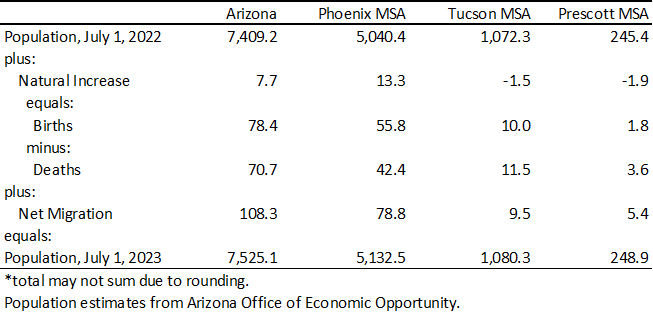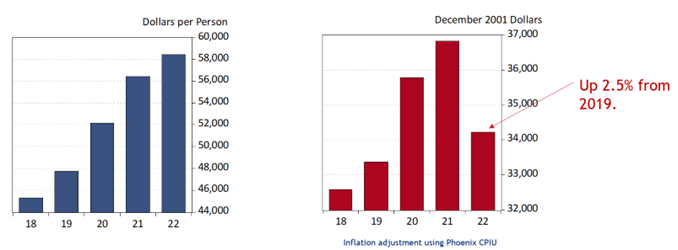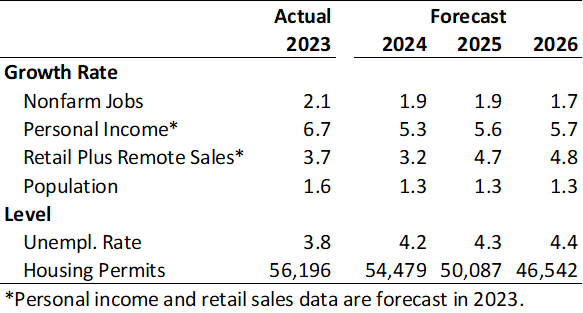First Quarter 2024 Forecast Update
By George W. Hammond, Ph.D., Director and Research Professor, EBRC
March 2024
The Arizona economy continues to churn out solid gains. Population growth slowed modestly in 2023, according to estimates from the Arizona Office of Economic Opportunity. U.S. Census Bureau estimates show a more significant slowdown. The state continued to add jobs in 2023, at about the same pace as the U.S. according to preliminary data. Income also continued to rise, outpacing decelerating inflation. Housing affordability remained low with high house prices and increased mortgage interest rates. Housing permit activity declined last year, again according to preliminary data.
The baseline outlook for the U.S., Arizona, Phoenix, and Tucson calls for continued near-term growth, although the pace of growth gradually decelerates. Even so, recession risks remain an important consideration. The pessimistic scenario calls for a modest U.S. downturn during the first half of 2024. That generates slower growth across Arizona, but not a significant downturn.
Arizona Recent Developments
Arizona’s population increased by 115,900 from July 1, 2022 to July 1, 2023, according to estimates from the Arizona Office of Economic Opportunity. That translated into 1.6% growth, down from 1.7% in 2022 but much faster than the U.S. at 0.5%.
The Phoenix MSA (Maricopa and Pinal counties) added 92,100 residents for 1.8% growth, while the Tucson MSA added 8,000 residents for 0.7% growth. The Prescott MSA added 3,500 residents, which translated into growth of 1.4% over the year. For each metropolitan area, population growth decelerated in 2023.
Population growth for states and local areas can be decomposed into two components: natural increase (births minus deaths) and net migration. Exhibit 1 shows these components of change for Arizona, Phoenix, Tucson, and Prescott. We take the population estimates in 2022 and 2023, as well as births and deaths, as given and estimate net migration as the residual. In other words, net migration is equal to the population change from 2022 to 2023 minus natural increase during the period.
Net migration remains the dominant source of population growth for Arizona and Phoenix and the only source of population growth for Tucson and Prescott (which both recorded more deaths than births last year). While natural increase was positive for the state as a whole and Phoenix, it was very weak.
Exhibit 1: Migration Drives Arizona Population Gains, Components of Change, Thousands
The U.S. Census Bureau also generates population estimates for state and local areas. The Census population estimates for Arizona are far lower than the estimates coming from the Arizona Office of Economic Opportunity. The current Census Bureau estimate for July 1, 2023 was 7,431,344, well below the Arizona Office of Economic Opportunity estimate of 7,525,113. Further, from July 1, 2022 to July 1, 2023, the Census Bureau estimates that the state added 65,700 residents for 0.9% growth. That was nearly one-half the pace estimated by the Arizona Office of Economic Opportunity. Estimating net migration from the Census Bureau estimate (using the residual method described above) yields 58,000. Metropolitan area and county population estimates from the Census Bureau for 2023 are not yet available.
The Arizona Office of Economic Opportunity and the U.S. Census Bureau generate population estimates using very different methodologies and the results are often different. The EBRC econometric models use the population estimates generated by the Arizona Office of Economic Opportunity on the assumption that local knowledge should improve the estimates. Estimates from both sources tend to generate large estimation errors over the decade between Census counts and both should be used with caution.
With the release of the December employment data, we now have preliminary full-year results for 2023 (Exhibit 2). On average in 2023, Arizona jobs rose by 64,700 over 2022, which translated into 2.1% growth. That was slightly below the national growth rate of 2.3%.
Phoenix MSA jobs rose 49,900 in 2023, up 2.2% from 2022, and Tucson MSA jobs rose 5,400, up 1.4% from 2022. Prescott MSA jobs rose 1,100 over the year for 1.6% growth.
Keep in mind that these data are preliminary and will be revised in March. For Tucson, these revisions can be substantial.
Exhibit 2: Arizona and U.S. Job Growth Rates, 2022-2023, Percent
For the state unemployment rate, the preliminary data put the 2023 annual average at 3.9%, up slightly from 2022 at 3.8% and above the U.S. at 3.8% in 2023.
Even though inflation has moderated recently, compared to 2022, price levels remain elevated. From December 2019 to December 2023, the Phoenix MSA all-items CPIU increased 24.0% and the national index rose 19.4%.
This raises the question about real incomes: are they higher or lower than before the pandemic after we adjust for inflation? Exhibit 3 provides the answer for Arizona. The state’s per capita personal income, before adjustment for inflation, increased by 22.5% from 2019 to 2022. After adjustment for inflation using the Phoenix CPIU, per capita personal income increases by 2.5%. Arizona income, by this measure, is higher than before the pandemic began, even after we take into account the impact of Phoenix inflation.
Exhibit 3: Arizona’s Real Per Capita Personal Income Was Above Pre-Pandemic Levels in 2022, Arizona Per Capita Personal Income Before and After Adjustment for Inflation
The combination of major increases in home prices and a rough doubling of mortgage interest rates has significantly damaged housing affordability. Single-family housing affordability remained weak in the fourth quarter of 2023. For the Phoenix MSA, 21.7% of homes sold were affordable to a family making the local median income, according to the National Association of Homebuilders and Wells Fargo. That was below the national average of 37.4%. Tucson MSA affordability was 32.5% in the fourth quarter and Prescott MSA affordability was 22.1%.
Across the board, housing affordability was far below pre-pandemic levels. In the fourth quarter of 2019, 63.2% of homes sold were affordable nationally and 64.9% were affordable in Phoenix. Tucson affordability was 71.2% and Prescott was at 55.9%.
While housing affordability has declined across Arizona, housing was much more affordable than in the major metropolitan areas of California. For instance, in San Diego, just 4.0% of homes were affordable, while the estimate was even lower in Los Angeles at 2.7%. San Francisco posted affordability at 5.7% and San Jose was at 7.1%.
Housing affordability can impact a wide variety of socio-economic outcomes, including homelessness, non-housing consumption spending, and migration. In the case of migration, Arizona remains a competitive destination, particularly relative to the major markets in California.
Arizona Outlook
The baseline forecast for Arizona, Phoenix, and Tucson calls for continued expansion. The state outlook is summarized in Exhibit 4. Arizona job growth is projected to decelerate from 2.1% in 2023 to 1.9% in 2024 and 2025 and then to 1.7% in 2026. Even so, Arizona job gains are expected to far outpace the nation.
Population growth is expected to slow from 1.6% in 2023 to 1.3% per year through 2026. The slowdown reflects moderating net migration during the period, as movement across the U.S. normalizes after a pandemic-driven surge and as reduced housing affordability (high home prices and rents, along with increased mortgage interest rates) weighs on mobility.
Housing permits are projected to drop in the near term, following reduced population gains and housing affordability.
Exhibit 4: Arizona Short-Run Outlook
Gains in Phoenix and Tucson are also expected to moderate a bit during the forecast period.
The forecast calls for Phoenix MSA job growth to decelerate modestly during the next three years. The slowdown is expected to be more significant in population growth, as the rate falls from 1.8% in 2023 to 1.5% by 2025. In contrast, population growth in Tucson dropped significantly in 2023 and is forecast to remain at its 2023 pace through 2026.
VIEW MOST RECENT FORECAST DATA FOR ARIZONA, PHOENIX, AND TUCSON
If your business or organization requires more timely and in-depth forecast data and analysis, find out about the benefits of joining EBRC’s Forecasting Project and email EBRC director George Hammond at ghammond@arizona.edu.
Copyright 2024 Economic and Business Research Center, The University of Arizona, all rights reserved.








